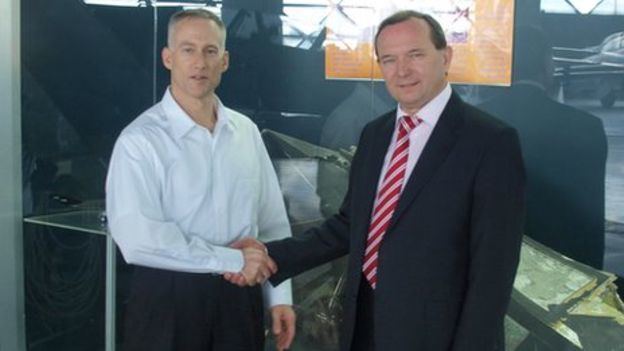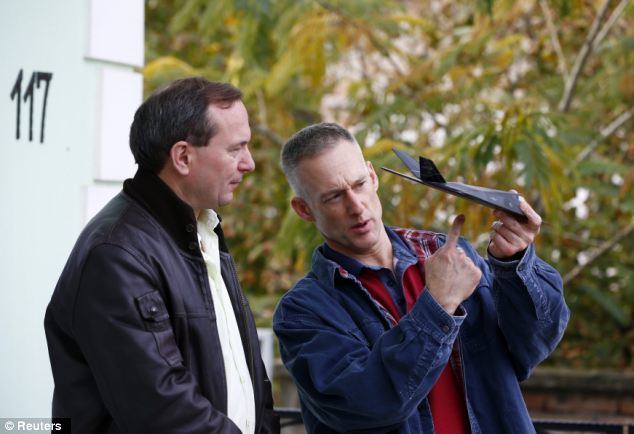Years of service Retired in 2004 | Name Zoltan Dani | |
 | ||
Allegiance SFR Yugoslavia,FR YugoslaviaSerbia and Montenegro Unit 250th Air Defense Missile Brigade Commands held 3rd battery of the 250th Missile Brigade Born 23 July 1956 (age 64) Kovin, PR Serbia, Yugoslavia | ||
Zoltan dani heroj 1 4
Zoltán Dani (Serbian Cyrillic: Золтан Дани) (23 July 1956 in Kovin) is a former colonel of the Yugoslav Army and former commander of the 3rd battery of the 250th Missile Brigade, which shot down an F-117 Nighthawk near the village of Buđanovci on 27 March 1999, during the Kosovo War. The hit was achieved with a SA-3 Goa SAM system. He was initially unknown to the public and aliased with the name Gvozden Đukić. However, upon retiring from the military, he revealed his identity.
Contents
- Zoltan dani heroj 1 4
- Zoltan dani heroj 2 4
- Preparations for the conflict
- The stealth kill
- Further combat activity
- In media
- References

Dani claimed that his battery also shot down an F-16 which according to NATO was lost due to "mechanical failure"; according to the crashed F-16's pilot, his aircraft was a victim of a SAM weapon.

Since retiring from military service, Dani has been working as a baker in his native village Skorenovac. He is an ethnic Hungarian from Serbia and his family originates from present-day Romania.
Zoltan dani heroj 2 4
Preparations for the conflict
Based on experiences of the 1982 Lebanon War, constant relocation of all assets was key to survival of Dani's unit, the 3rd missile detachment of the 250th Serbian Air Defence Battalion. Although the SA-3 / "S-125M Neva" system is not a mobile SAM complex per design, its solid fueled missiles are transportable in near combat ready condition (in fact the Polish Armed Forces and Cuban Revolutionary Armed Forces each created mobile versions of the SA-3 on T-72 tank and T-55 tank chassis respectively in the 1990s).

Therefore, Lt. Col. Dani trained his SA-3 unit to achieve a 90-minute equipment break-down time with minimal lighting provided for better camouflage, one hour better than the standard time. Further set-up and break-down time reductions were achieved by reducing the SA-3 unit's number of active 5P73 launchers and V-601M missiles to just 2x2 from the original 4x4 configuration.
This reduction in missile capability was justified, because of the expected strictly limited time slots and occasions where a Serbian SAM battery could open fire in face of a tremendous NATO Wild Weasel capability, with any hope of self-preservation. The lean use of SAM missiles also became a necessity later on, as the initial March 24, 1999, 20:20 NATO air strike destroyed a hundred reloads of ready to use V-601M missiles stored in two concrete vaults at the Jakovo SAM base.
Lt. Col. Dani made it a strict field rule that the SA-3's UNV type fire control radar could only be turned on for a maximum of 2 x 20 seconds in combat, after which the battery's equipment must be immediately broken down and trucked to a prepared alternative launch site, whether or not any missile has been fired. This rule proved essential, because other Serbian AAA units, emitting high-frequency radiation for any longer periods or forgetting to relocate, were hit by AGM-88 HARM missile counter-strikes from NATO aircraft, suffering radar equipment and personnel losses.
In order to train personnel to operate efficiently under such pressures, Zoltán Dani obtained access to an "Accord" electronic signal simulator, which allowed the SA-3 radar and guidance crew practice combat scenarios based on imitated engagements. Several soldiers were removed from position both during the pre-war practice drills and wartime guard shifts, when they proved unable to cope with the psychological stress of being targeted by enemy aircraft.
It was decided two missiles would be launched against any target near simultaneously, in order to maximize hit probability. Unusually, launches were to be conducted against NATO aircraft that had already accomplished their ground strike missions and were about to leave Serbian airspace. Their northern heading was pointing away from the direction of powerful NATO airborne jammer sources, thereby allowing the SA-3's un-modernized UNV fire control radar set to operate with less interference.
Dani's mobility rule was strictly observed in his unit, with the trucks relocating frequently during the 78 days of Kosovo War, as they constantly shuttled missiles, radars and equipment among the dozen alternative launch sites, most of them embankments left over from already phased out SA-2 (S-75) units.
Radar sets obtained from confiscated Iraqi MiG-21 planes were planted around the SAM sites to serve as active emitter decoys, which diverted some anti-radiation missiles from the actual targets (dozens of Iraqi MiG-21/23 warplanes, sent to Yugoslavia for industrial overhaul, were seized in 1991, after Saddam Hussein's invasion of Kuwait.) Retired SAM radar sets were used as optical decoys, left at well-known military bases to lure NATO planes to waste munition on worthless targets. Owing to these measures, Dani's unit evaded 23 incoming HARM missiles, all of which impacted off-site with insignificant or zero damages.
General surveillance of NATO aircraft was provided by vintage P-18 radar sets, which used vacuum tubes and a large rotating Yagi antenna grid for meter-band illumination. Under optimal conditions the Soviet-made P-18 was able to plot large-Radar cross-section aircraft from 125 to 200 km, depending on the target's size, but with a high range inaccuracy of several hundred meters.
Zoltán Dani tuned his P-18 to the lowest possible frequency, hoping that meter band waves would reflect from the inside of targets, rendering stealth aircraft skin technology ineffective. In practice his modified P-18 provided stable plot of F-117 movements from just 25 km, which was useful when combined with the comparatively short missile range of the SA-3 air defence complex. Furthermore, the P-18 meter band radar could be kept almost constantly emitting, since most NATO radar warning receiver devices did not cover such a very low frequency band.
Zoltán Dani initially claimed that four major capacitors had been replaced in the P-18, to further increase the wavelength. However, he later admitted that no such modifications had been made, and that his story was a "marketing trick."
The stealth kill
On the particular night of the F-117 shootdown, 27 March 1999, Zoltán Dani broke his own ruleset. He had information about unfavourable Adriatic weather conditions and Serbian spies residing near Italian NATO airbases informed the Serbian Air Defence HQ about lack of EA-6 Prowler electronic jammer and "Wild Weasel" anti-SAM aircraft launches during the late evening. Therefore, any F-117s in the air on that fateful night were alone in the dark, but with high crew morale due to their invulnerability during previous day's sorties.
In the evening, Dani's P-18 long-distance radar set malfunctioned at 19:05, almost the same time when four F-117s prepared for take-off from Aviano Air Base to attack targets in Belgrade. The repaired P-18 radar returned to air by 19:50 and started to emit lower frequency. Lt. Col. Dale Zelko's plane (tail number 82-0806) and three other F-117 flying northbound were acquired at 20:40 local time and so the SA-3 battery's fire control radar went on air. The UNV radar emitted at high frequency for 2 x 20 seconds, but it was unable to obtain a lock on the targets.
Lt. Col. Dani then ordered a third illumination round, against his own rules, but knowing that NATO lacked immediate counterstrike capability on the particular occasion. Lock was obtained at a distance of 13 km and an altitude of 8 km. Two SA-3 missiles were launched in short succession, with one obtaining a proximity fuse hit, as notified by an automatic radio pinger burst. The F-117 was structurally disabled by the sudden minus 6G negative load and stall-crashed in inverted position in an agricultural field, near the village of Buđanovci. The pilot ejected successfully and was rescued later on by NATO Combat search and rescue helicopters. The F-117's large kite-shaped titanium engine outlet heatshield is still kept by Dani in his garage.
Further combat activity
Zoltan Dani also claims that his unit downed the commander's F-16 plane from the Aviano-based 555th Fighter Squadron "Triple Nickel". On May 1/2, 1999 the F-16 (s/n 88-0550) had already completed its combat sortie and was flying outbound from Serbian airspace, when its on-board radar warning receiver indicated illumination from Dani's SA-3 fire control radar. The pilot, Lt. Col. David L. Goldfein, decided to turn back and attack, but this proved a mistake, as two missiles were already underway and one hit his plane. Dani was not actually in the combat shift (for a unit to provide 24h/day readiness the crew is divided in 3 shifts) when the shootdown occurred. The shift was commanded by Maj. Boško Dotlić.
The radio signal logs of unit 250/3 contain two further proximity fuse activation pings beyond the F-117 and F-16 shootdown events, indicating that either extra NATO aircraft were hit or ALE-50 towed jammer devices were destroyed by the missiles, as opposed to the SAM missiles simply missing due to radar jamming or chaff dispersal.
Although Ret. Col. Zoltán Dani does not comment on the allegation (although Dani's wartime second in command Lt Col Đorđe Aničić does), as of mid-2009 some Hungarian aviation journalists claim one of these two events was a real hit on a B-2 Spirit stealth bomber, which was either totalled or extensively re-built after an overseas crash landing (this plane was previously believed to be another combat-damaged F-117).
In media
Ten years after the events, the Hungarian military aviation magazine Aranysas, volume 11/2009, carried an extensive article on Zoltán Dani's story, on the occasion of his visit at the Hungarian Air Defence Collection, an NGO-operated SAM museum at Zsámbék. Certain aspects of the F-117 shootdown story and general Serbian AAA activity during the Kosovo War were publicly disclosed for the first time in the article.
A documentary movie The 21st Second was made about Zoltán Dani. Dani also participated in the documentary movie The Second Meeting, where he met Dale Zelko, the F-117 pilot he had shot down.
